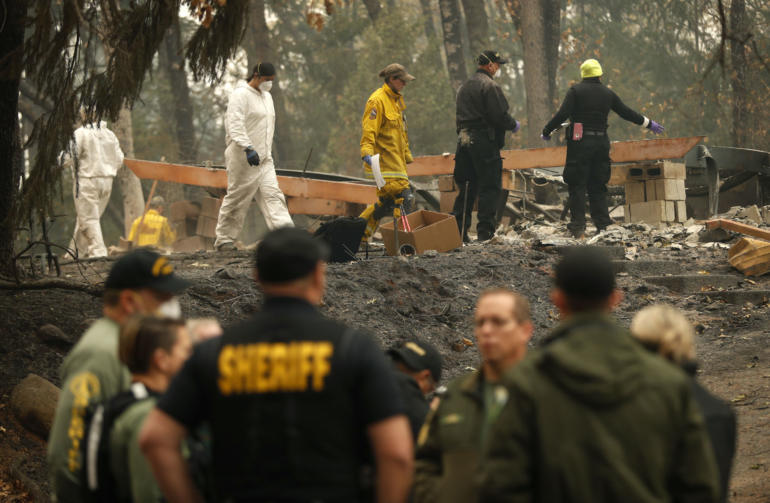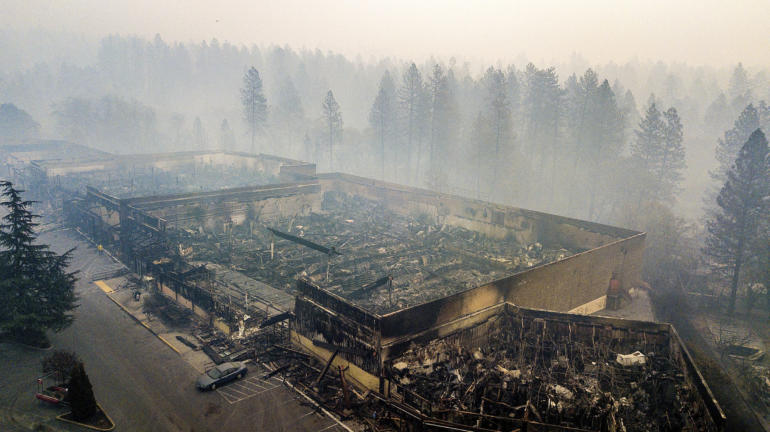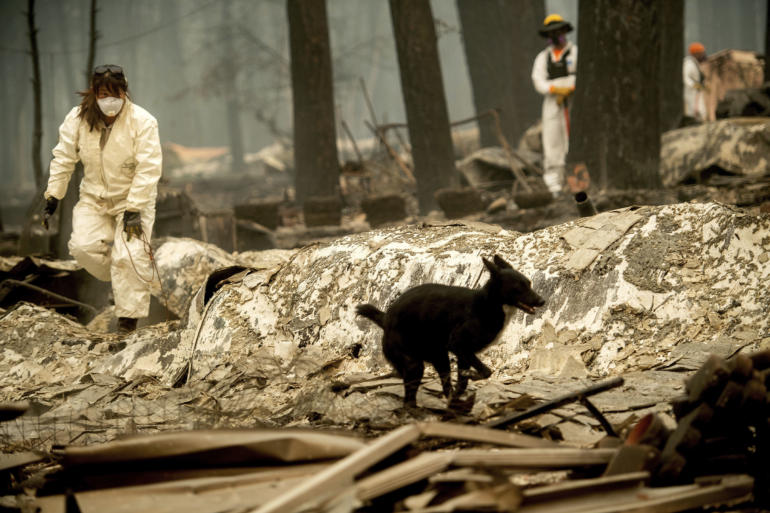At least 63 people are now dead from a Northern California wildfire, and officials say they have a missing persons list with 631 names on it in an ever-evolving accounting of the victims of the nation’s deadliest wildfire in a century.
The high number of missing people probably includes some who fled the blaze and don’t realize they’ve been reported missing, Butte County Sheriff Kory Honea said. He said he’s making the list public so people can see if they are on it and let authorities know they survived.
“The chaos that we were dealing with was extraordinary,” Honea said of the early crisis hours last week. “Now we’re trying to go back out and make sure that we’re accounting for everyone.”

Investigators recover human remains at a home burned in the Camp Fire, Thursday, Nov. 15, 2018, in Magalia, Calif. Many of the missing in the deadly Northern California wildfire are elderly residents in Magalia, a forested town of about 11,000 north of the destroyed town of Paradise. (AP Photo/John Locher)
Some 52,000 people have been displaced to shelters, the homes of friends and relatives, to motels — and to a Walmart parking lot and an adjacent field in Chico, a dozen miles away from the ashes.
At the vast shelter parking lot, evacuees from California’s deadliest fire wonder if they still have homes, if their neighbors are still alive — and where they will go when their place of refuge shuts down in a matter of days.
“It’s cold and scary,” said Lilly Batres, 13, one of the few children there, who fled with her family from the forested town of Magalia and didn’t know whether her home survived. “I feel like people are going to come into our tent.”
The Northern California fire that began a week earlier obliterated the town of Paradise. Searchers have pulled bodies from incinerated homes and cremated cars, but in many cases, the victims may have been reduced to bits of bones and ash. The latest toll: 63 dead and 9,800 homes destroyed.

FILE – In this Thursday, Nov. 15, 2018 file photo smoke hangs over the scorched remains of Old Town Plaza following the wildfire in Paradise, Calif. Most homes are gone, as are hundreds of shops and other buildings. The supermarket, the hardware store, Dolly-O-Donuts & Gifts where locals started their day with a blueberry fritter and a quick bit of gossip, all gone. The town quite literally went up in smoke and flames in the deadliest, most destructive wildfire in California history. (AP Photo/Noah Berger, File)
At the other end of the state, more residents were being allowed back into the zone of a wildfire that torched an area the size of Denver west of Los Angeles. The fire was 62 percent contained after destroying nearly 550 homes and other buildings. At least three deaths were reported.
Air quality across large swaths of California remains so poor due to huge plumes of smoke that schools from Sacramento to the Pacific Coast were closed on Friday, and San Francisco’s iconic open-air cable cars were pulled off the streets.
Northern California’s Camp Fire was 40 percent contained Thursday, but there was no timeline for allowing evacuees to return because of the danger. Power lines are still down, roads closed, and firefighters are still dousing embers, authorities said.
Anna Goodnight of Paradise tried to make the best of it, sitting on an overturned shopping cart in the parking lot and eating scrambled eggs and tater tots while her husband drank a Budweiser.
But then William Goodnight began to cry.
“We’re grateful. We’re better off than some. I’ve been holding it together for her,” he said, gesturing toward his wife. “I’m just breaking down, finally.”

Suzanne Kaksonen, an evacuee of the Camp Fire, and her cockatoo Buddy camp at a makeshift shelter outside a Walmart store in Chico, Calif., on Wednesday, Nov. 14, 2018. Kaksonen lost her Paradise home in the blaze. (AP Photo/Noah Berger)
More than 75 tents had popped up in the space since Matthew Flanagan arrived last Friday.
“We call it Wally World,” Flanagan said, a riff off the store name. “When I first got here, there was nobody here. And now it’s just getting worse and worse and worse. There are more evacuees, more people running out of money for hotels.”
Word began to spread Thursday that efforts were being made to phase out the camp by Sunday, by gradually removing donated clothing, food and toilets.
“The ultimate goal is to get these people out of tents, out of their cars and into warm shelter, into homes,” said Jessica Busick, who was among the first volunteers when she and her husband started serving free food from their Truckaroni food truck last week. “We’ve always known this isn’t a long-term solution.”
A Sunday closure “gives us enough time to maybe figure something out,” said Mike Robertson, an evacuee who arrived there on Monday with his wife and two daughters.
It’s unclear what will be done if people don’t leave Sunday, but city officials don’t plan to kick them out, said Betsy Totten, a Chico spokeswoman. Totten said volunteers — not the city — had decided to shut down the camp.
Walmart has added security to the location and is concerned about safety there, but it is not asking people to leave, spokeswoman LeMia Jenkins said.
Some, like Batres’ family, arrived after running out of money for a hotel. Others couldn’t find a room or weren’t allowed to stay at shelters with their dogs, or in the case of Suzanne Kaksonen, her two cockatoos.
Kaksonen said it already feels like forever since she’s been there.
“I just want to go home,” she said. “I don’t even care if there’s no home. I just want to go back to my dirt, you know, and put a trailer up and clean it up and get going. Sooner the better. I don’t want to wait six months. That petrifies me.”

Denise Chester, an evacuee of the Camp Fire, hugs her son Antonio Batres as she volunteers sorting clothes at a makeshift shelter in Chico, Calif., on Wednesday, Nov. 14, 2018. Chester, who doesn’t want to know yet whether her home survived, said “I want to help. I don’t want to shut down.” (AP Photo/Noah Berger)
Some evacuees helped sort immense piles of donations that have poured in. Racks of used clothes from sweaters to plaid flannel shirts and tables covered with neatly organized pairs of boots, sneakers and shoes competed for space with shopping carts full of clothes, garbage bags stuffed with other donations and boxes of books. Stuffed animals — yellow, purple and green teddy bears and a menagerie of other fuzzy critters — sat on the pavement.
Food trucks offered free meals and a cook flipped burgers on a grill. There were portable toilets, and some people used the Walmart restrooms.
Someone walking through the camp Thursday offered free medical marijuana.
Information for contacting the Federal Emergency Management Agency for assistance was posted on a board that allowed people to write the names of those they believed were missing. Several names had the word “Here” written next to them.
Melissa Contant, who drove from the San Francisco area to help out, advised people to register with FEMA as soon as possible, and to not reveal too much information about whether they own or rent homes or have sufficient food and water, because that could delay aid.
“You’re living in a Walmart parking lot — you’re not OK,” she told Maggie and Michael Crowder.
Story by the Associated Press.
 CGTN America
CGTN America
 Search and rescue workers look for bodies of Camp Fire victims at the Holly Hills Mobile Estates on Wednesday, Nov. 14, 2018, in Paradise, Calif. (AP Photo/Noah Berger)
Search and rescue workers look for bodies of Camp Fire victims at the Holly Hills Mobile Estates on Wednesday, Nov. 14, 2018, in Paradise, Calif. (AP Photo/Noah Berger)
